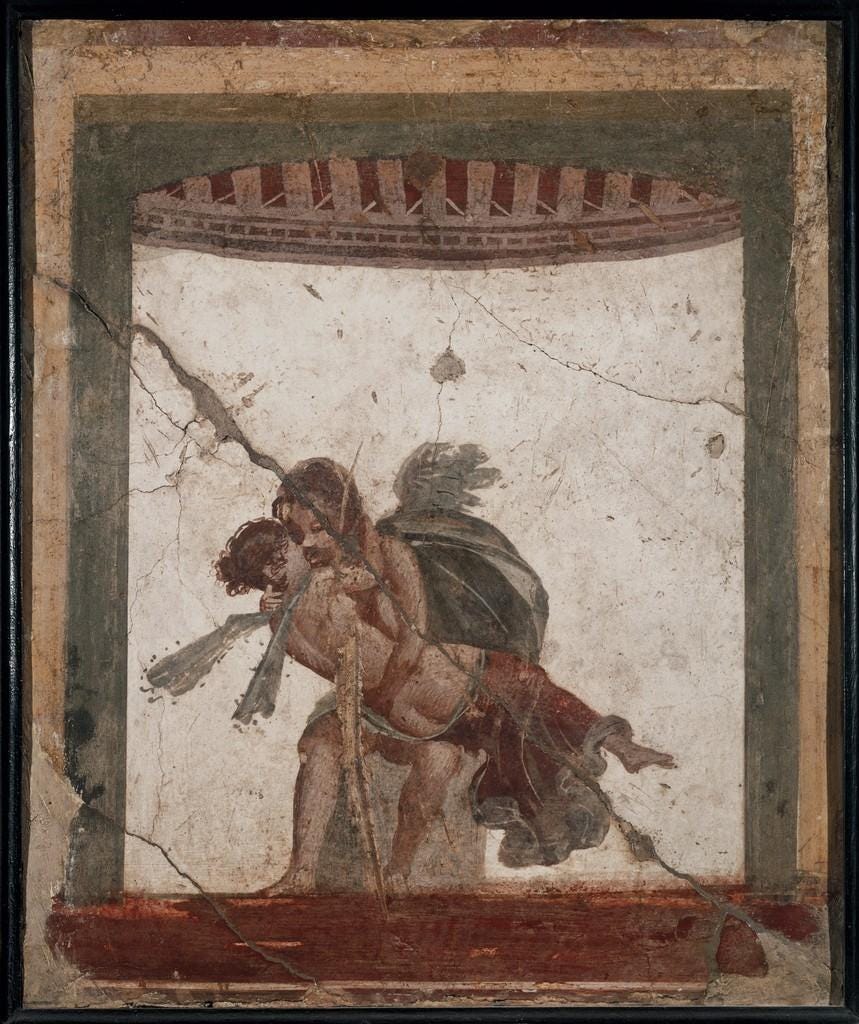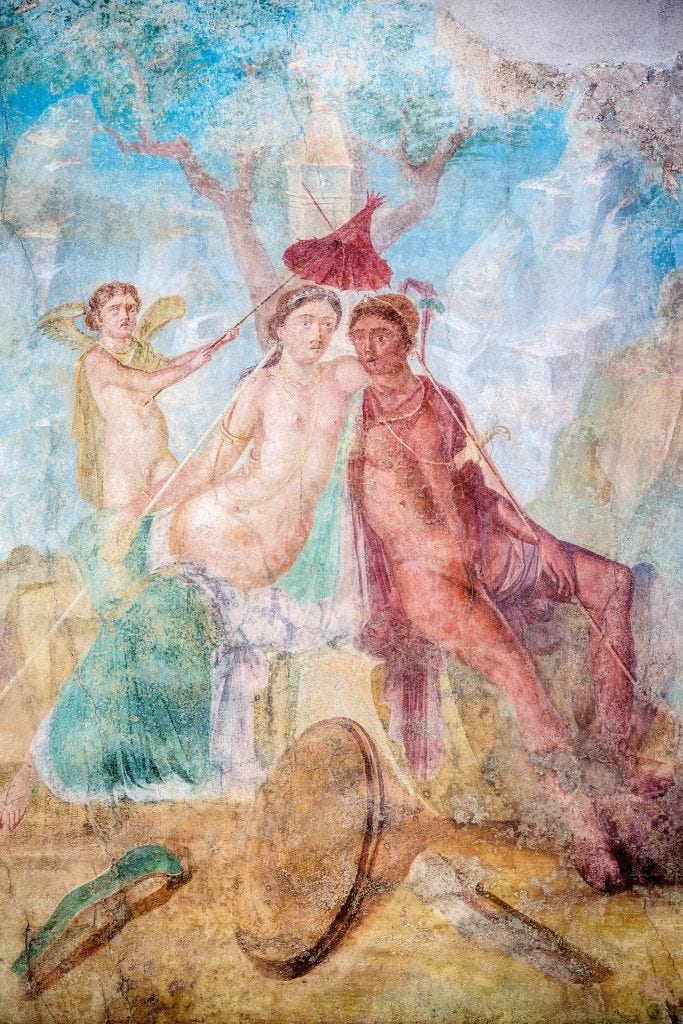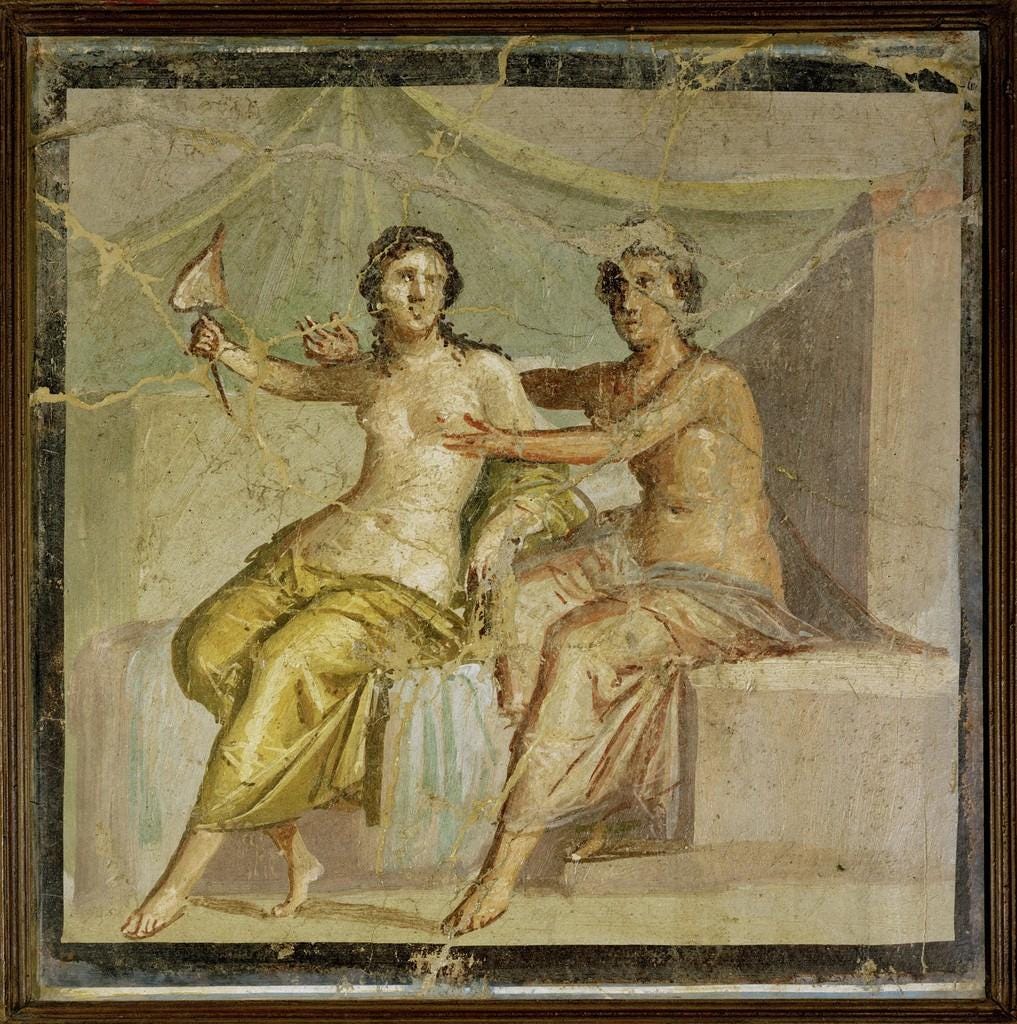Divine and Mortal Couples: Intimacy and Desire in Ancient Roman Wall Painting
By Sana McDowell (University of Toronto)
If there’s one thing the Ancient Romans and I have in common, it’s that we refuse to leave a single wall undecorated. What we don’t have in common is that my walls aren’t covered with pictures of people having sex. Yep, you read that correctly; the Romans painted pictures of couples having sex EVERYWHERE! No, I’m just kidding; didn’t anyone tell you not to believe everything you read online?
Seriously though, what I said wasn’t a total exaggeration, and representations of couples had an important place within the Ancient Roman home (or at least within the homes which stayed preserved long enough for modern architects to see them). While there are a range of paintings which involve erotic content in particular, I’m only going to address painted couples who seem to be interested in each other. Stories depicting rape or kidnapping or even just one-sided ogling aren’t going to be part of this! Also, while polyamorous relationships shouldn’t be baselessly rejected from historical explorations of romance, I’m not going to discuss them here because paintings of group scenes are mostly depicted to emphasize how wild the people participating are, so they likely weren’t seriously considered within contemporary culture (or at least not in public).
So with that being said, I have to confess that after these limitations, and with the limitation that I’m only talking about works that were present in domestic spaces, there actually isn’t as much erotic content in this article as I may have led you to believe. But wait! Don’t go away, you sex fiend! There are still a lot of beautiful things to be seen and learned, so stick with me here, and let me take you on a little trip through the Ancient Roman home.
What’s fascinating about the way Ancient Romans approached domestic space is that the home was much more public than what we’re used to. The people who would have owned the houses that display the art which still stands today were definitely wealthy and probably politically powerful as well. Think about the White House. Technically it’s where the President and his family live, but it’s also open to the many other political figures they invite there and to the general public. Ancient Roman homeowners (or maybe I should say mansion-owners) had to think not only about what they wanted to see in their house, but what they wanted other people to see, and what they wanted other people to know they commissioned.
The content of a painting was also informed by the architecture of its home. Larger public rooms, like the atrium, boasted grand paintings that sparked discussion among guests and showed off the owner’s taste and even their personal style. On the other hand, smaller, more private rooms like the tribiculum or cubiculum housed humble, idyllic scenes for their patrons to enjoy on the daily. These would have still been seen by close friends and family, as well as the servants which were present in these rooms at all times.
With this in mind, when we look at the depictions of couples found in these different rooms, there does seem to be a pattern. A typical example of the kind of painting you’d find in an atrium, for example, would be this one depicting the marriage of Jupiter and Juno. As the King of gods and goddess of marriage respectively, Jupiter and Juno’s portrait serves as a blessing to the couple who owned the house. This painting in particular isn’t just a great example because of how typical its scene is, but also because its message is informed by the paintings nearby.
The movement of the eye across an artistic space is and was a key part of understanding visual narratives in the Roman home. Using the example of Juno and Jupiter, all of the other paintings which are shown in the same room are of mythological scenes involving the ownership of a woman (through marriage, abduction, or war). The Romans were obsessed with Ancient Greek mythology, so they would have a) easily been able to identify the stories being shown, and b) understood that range of other themes that the patron could have chosen to display.
After looking at these other paintings, the theme between them reveals a different way to read the image of Juno and Jupiter, who now have a spotlight on their gendered power dynamic. Jupiter gets to chill on his throne while Juno stands at attention in front of him. The way they are posed, with Jupiter holding Juno’s hand, is pretty common in marriage scenes, and it signified the change in ownership and in social status that a woman went through when transforming from a single to a married woman. This is also a much more serious way of looking at a couple, where their legal arrangement is more on display then their personal feelings.
Other mythological scenes embrace the emotion between a couple, and one thing that the Romans loved to see in their media was desire. Of all the drama that a person can find in Ancient Greek Mythology (think monsters, war, betrayal, etc), they often leaned towards subjects of romance and desire.
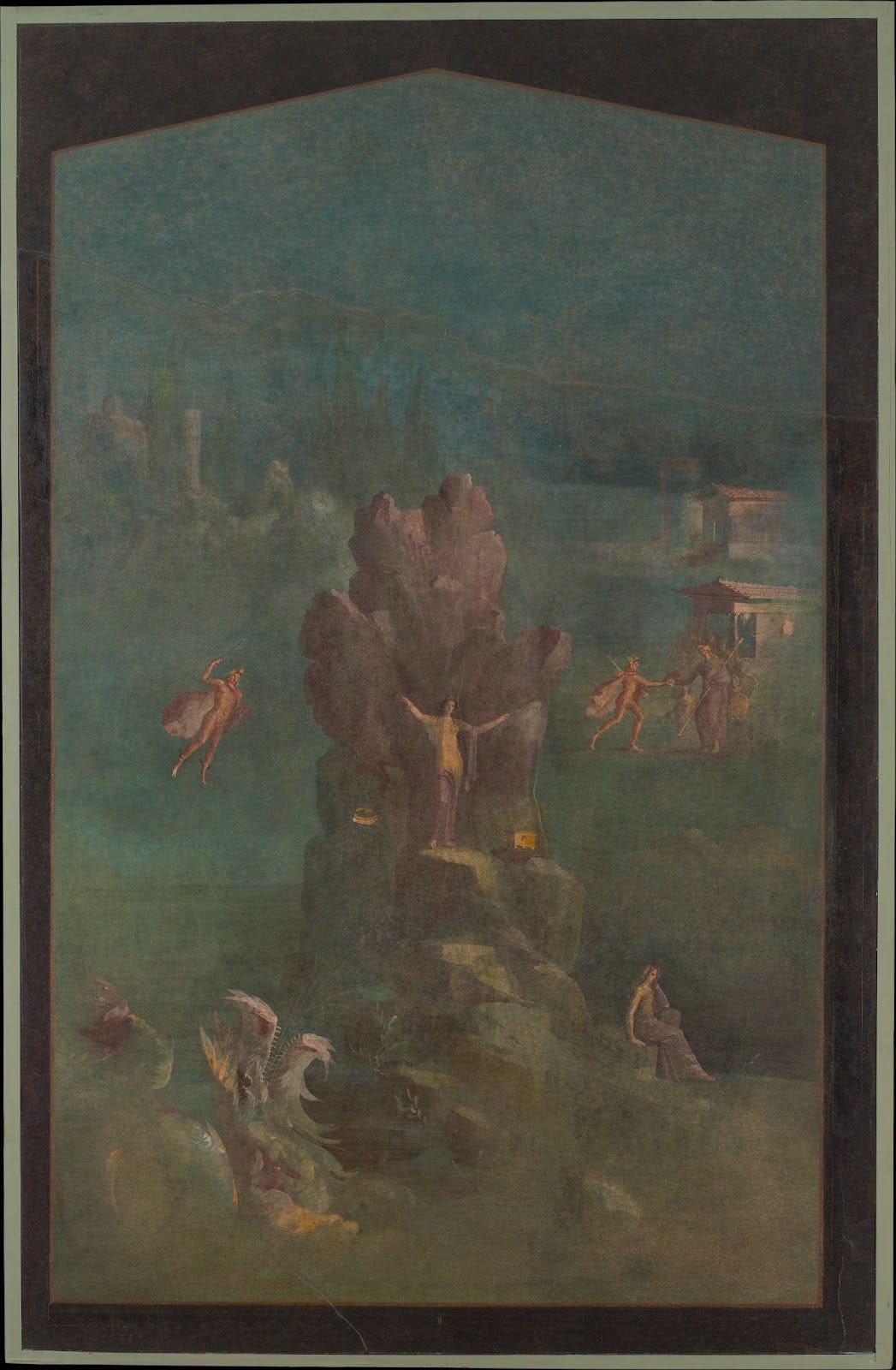

Two very large and elaborate scenes of Perseus with Andromeda (top) and Polyphemus with Galatea (bottom) in the Augustan Villa in Pompeii show that a quest in the name of desire could easily carry the decoration of an entire room. The size and skill of the artists suggest that their patron was on their own quest to impress their guests, and that the patron ultimately believed these stories centered on desire would do the job.
In the House of Octavius Quartio, the couple Pyramus and Thisbe are spotlighted for their romance rather than the other tensions that were part of their story. The patron of this house definitely had the choice of going for a much more violent or tragic scene. Instead, the couple lie in relatively relaxed positions against an idyllic backdrop, with the lion standing far, far away. There is a tender emotion between them.
The lovers’ contemporarily ideal proportions and full nudity also show off their beauty and youth even while riddled with wounds. This plays along with the greater theme of physical desire, which dominates the other paintings in the same room. There is a portrait of Actaeon and Diana, Pero and Mycon, and a portrait of Narcissus set across a real fountain to represent him looking at himself (because nobody has ever desired anyone more than Narcissus desired himself). And, as if things couldn’t get more obvious, a flock of cupids spread out between the connecting walls to guide the eye across them all.
Interestingly, one fresco in the House of Caecilius Iucundus uses a satyr and maenad in a similarly isolated scene, despite their usual use as personifications of man’s flaws. We can see how this one’s more raunchy because its subjects aren’t as divine. Its presence in the home suggests an interest in lesser divine couples, who in turn represent a different side of human couples as well.

The choice of which gods and divine beings to include in the home shows us what aspects of love were idealized by certain patrons. In the same way that many of us have our own favorite celebrity couples, so did people obsessed with Ancient Greek mythology. What better celebrity is there than a god? Some couples are just so iconic that we can make pretty fair assumptions about how to interpret a painting just based on who’s in it.

This painting of Bacchus and Ariadne speaks to needing no loftier goal than enjoying your lover’s company, and it’s suggested by Bacchus’s divine identity alone, since he’s known for doing nothing except pursue pleasure.
Other paintings transform the characters a bit to do something more specific. This fresco of Cupid and Psyche fresco paints them as children, even though both of them are canonically adults. This is so they can personify youthful, innocent passion. The soft, diffuse strokes used to paint them and the depth of their kiss only add to this effect.
Venus and Mars, on the other hand, are the quintessential divine adult couple, and they’re painted a lot despite the fact that Venus is actually married to Vulcan. This is because Venus and Mars - the rulers of Love and War - were each seen as the pinnacle of their respective genders. Their identities are so powerful that most existing images don’t even bother putting them in a narrative, and they tend to just hang out or passively flirt with each other in their frames. Here, they feel distinctly casual and there’s no sense that this should or will change. The paradise behind them helps to suggest that among the many ideals Ancient Romans had, an idyllic love was - at least for some - one of them.
Incidentally, paintings of Venus and Mars, also give us a unique take on gender dynamics. In the House of the Punished Love, Venus sits in a seat of power in the same way Jupiter does.
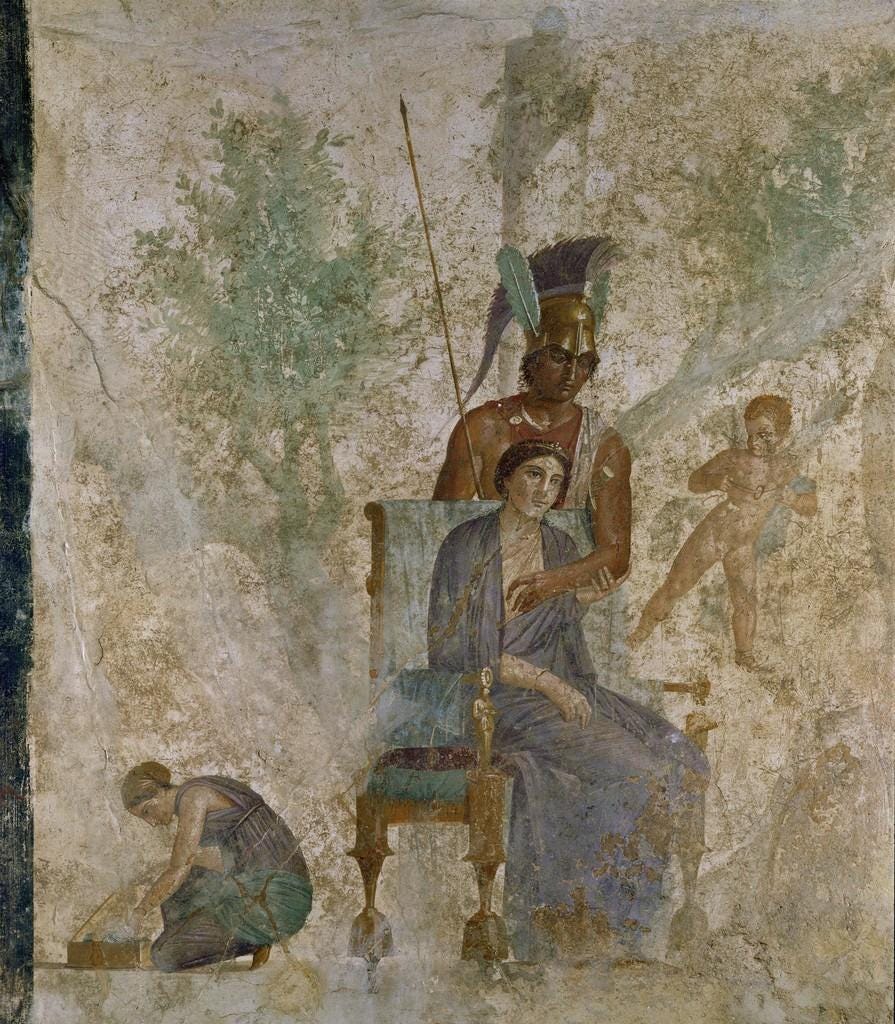
While Mars stands behind her throne and tries to seduce her, Venus holds Mars’s arm and stays in control of the situation. In other words, Mars wants Venus, but it’s up to her whether he gets to even hug her, and she doesn’t care either way.
Another painting shows Venus holding an object away from Mars as he tries weakly and unsuccessfully to take it back from her. This format suggests an interest in men (Mars) submitting to love (Venus) rather than obsessing over war.
Unlike other scenes where the person being pursued has to at least pretend they don’t want to be pursued to maintain their chastity, Venus is understood and accepted as a seductive being. Her involvement in romance is up to her entirely. Her existence is an acknowledgement of the power women could have in the context of a romantic couple, and that role is reflected in paintings of mortal couples too.
The following two paintings were found facing each other in the same cubiculum:


Both works show women voraciously initiating sexual activity with their husbands. Their sexual acts are painted in the context of normal life, where the elite couple’s staff of servants bustle around in the background, ignoring the action in front of them. In a different house, the painting below shows a tree view - which symbolized class - appearing behind another couple actively having sex with the woman on top.

These paintings act as evidence against the records of ancient, elite men who were disgusted by women taking sexual initiative. Unlike similar paintings in the Pompeii baths, these are less likely to be satirical or joke pieces because the couples shown in the confines of the bedroom are probably meant to reflect the married couple who actually sleeps there every night.
In fact, the Roman bedroom provides the setting for nearly all scenes between mortal lovers within the home. When couples aren’t painted with any background, this usually seems to be because the painter was cheaper and less skilled. That mortal couples were usually placed in the setting of the bedroom, though, indicates a Roman interest in the romance of private life.

The couple painted in the House of Caecilius Iucundus gives its audience a view from behind the couple’s bed as the husband and wife, fully nude, begin their day. At this angle, the viewer can see the husband reach to touch his naked wife as she rises from the bed. Here we get a glimpse of a raw, honest ideal moment in a real couple’s private life.
In this vein of domestic realism a range of moments are considered, from serious conversation to relaxed intimacy.

I’d also like to point out that, across paintings of divine and mortal couples, there are similar visual schemes used that emphasize the intention for real human beings and painted gods to reflect each other. In art - as in life - it is often necessary and always possible to express desire without words. Figures show interest in one another through their pose, like by hugging or leaning into each other.
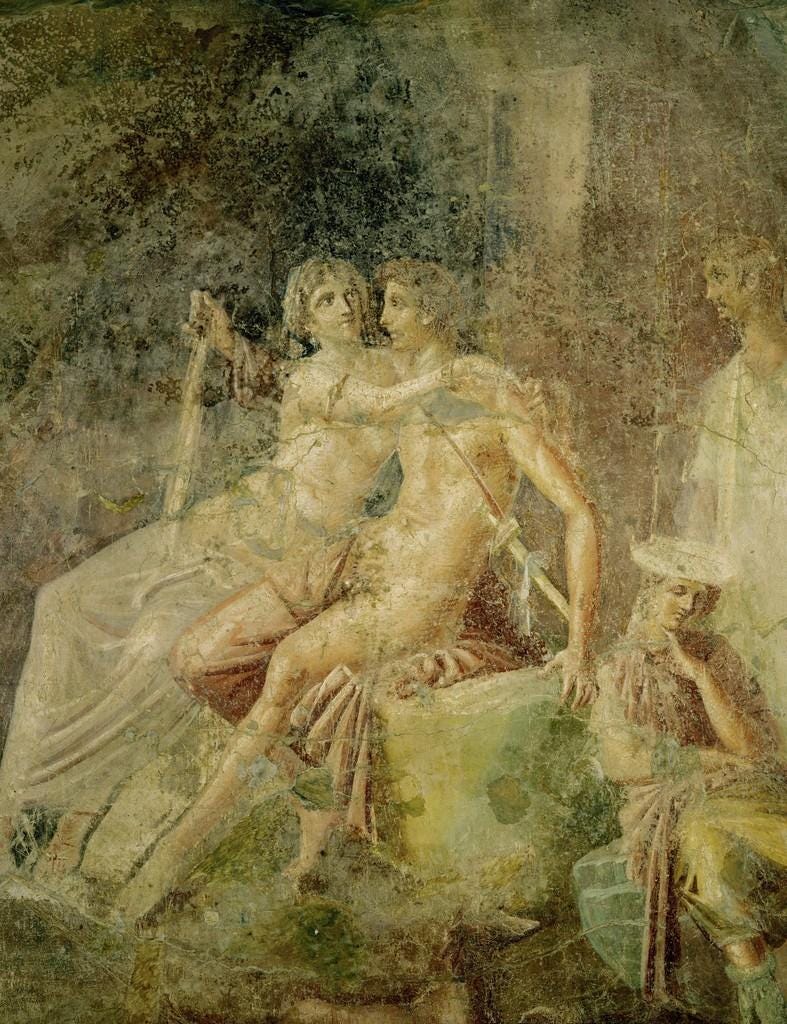
Also, whenever you see a figure in a Roman painting holding an arm over their head, this is because that’s meant to be a seductive move, and it’s been used indiscriminately. For example, Venus uses the pose to seduce Mars (top), while a mortal man seduces his own partner (bottom).


With the common languages of art and the body, these paintings use gods and mortals to embody lived ways of wanting. Gods are used to demonstrate ideals that were separate from sex, and mortals tapped into real parts of married life. There are scenes to mimic, couples to idealize, and even couples to laugh at. This reflects a culture which not only accepted, but was fascinated by desire in many forms and by many people
Bibliography:
Bergmann, Bettina. “The Roman House as Memory Theater: The House of the Tragic Poet in Pompeii.” The Art Bulletin, vol. 76, no. 2, 1994, pp. 225–56. JSTOR, https://doi.org/10.2307/3046021.
Clarke, John R. Looking at Lovemaking: Constructions of Sexuality in Roman Art, 100 B.C. – A.D. 250. University of California Press, 2014.
Clarke, John R. "Sexuality and visual representation." A companion to Greek and Roman sexualities (2013): 509-533.
Fredrick, David. “Beyond the Atrium to Ariadne: Erotic Painting and Visual Pleasure in the Roman House.” Classical Antiquity 1 October 1995; 14 (2): 266–288. https://doi.org/10.2307/25011023.
Sandhoff, Bridget. "Romancing the Sexes: Representations of Marital Love in Etruria." Past and Present: Perspectives on Gender and Love. Brill, 2015. 91-106. https://doi.org/10.1163/9781848883918_010.
Valladares, Hérica. "Fallax Imago: Ovid's Narcissus and the seduction of mimesis in Roman wall painting." Word & Image 27.4 (2011): 378-395. https://doi.org/10.1080/02666286.2011.563063.
Wallace-Hadrill, Andrew. “The Social Structure of the Roman House.” Papers of the British School at Rome, vol. 56, 1988, pp. 43–97. JSTOR, http://www.jstor.org/stable/40310883.
Sana McDowell is a 4th year student pursuing a degree in Psychology and Art History. Her research interests are centered on the ways in which people interpret and come to understand one another.






